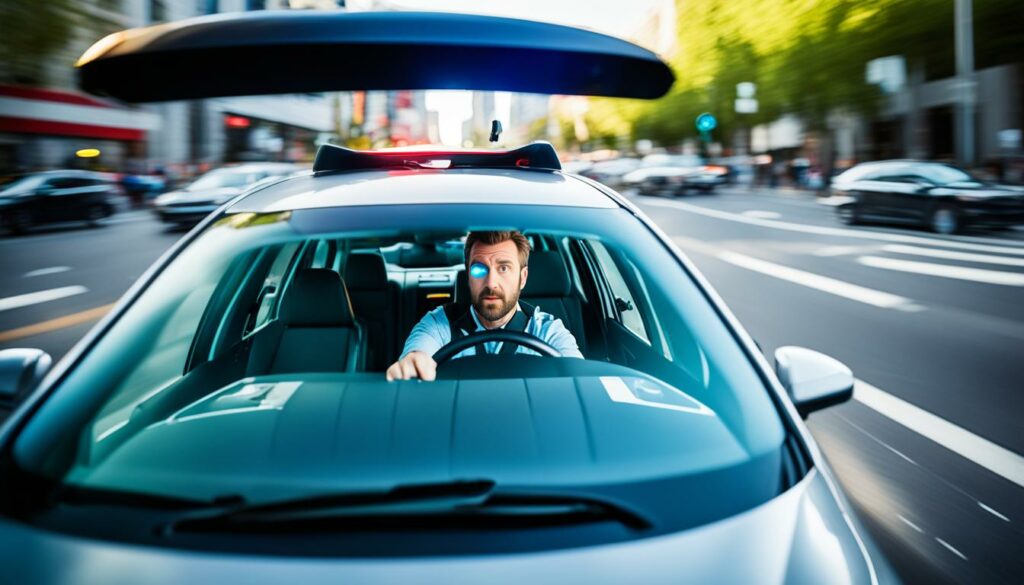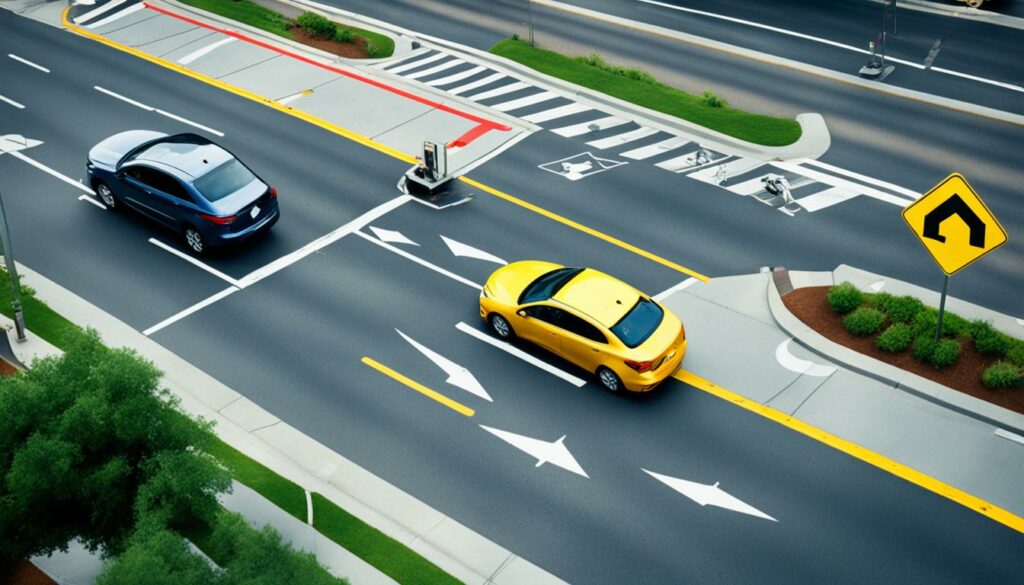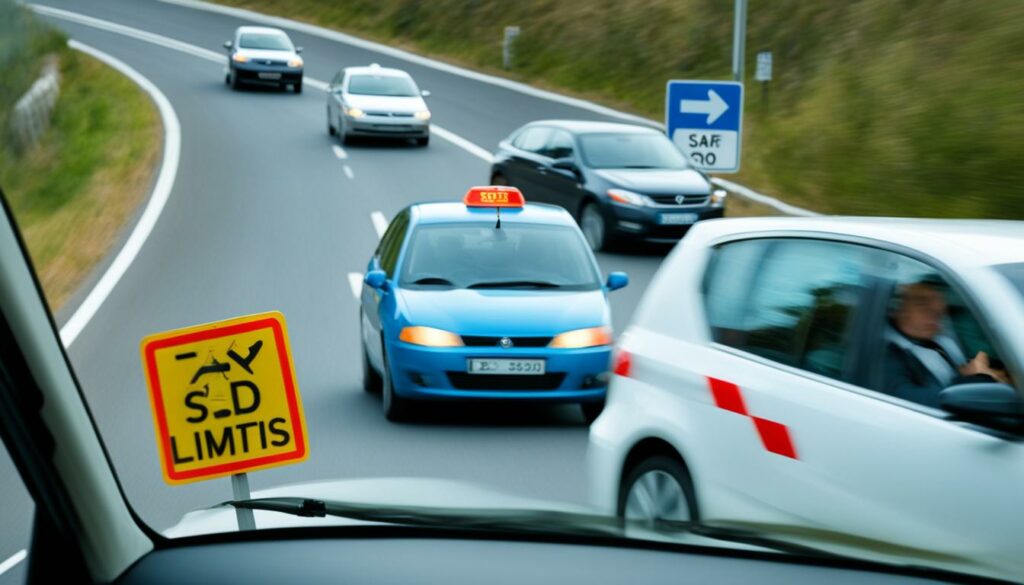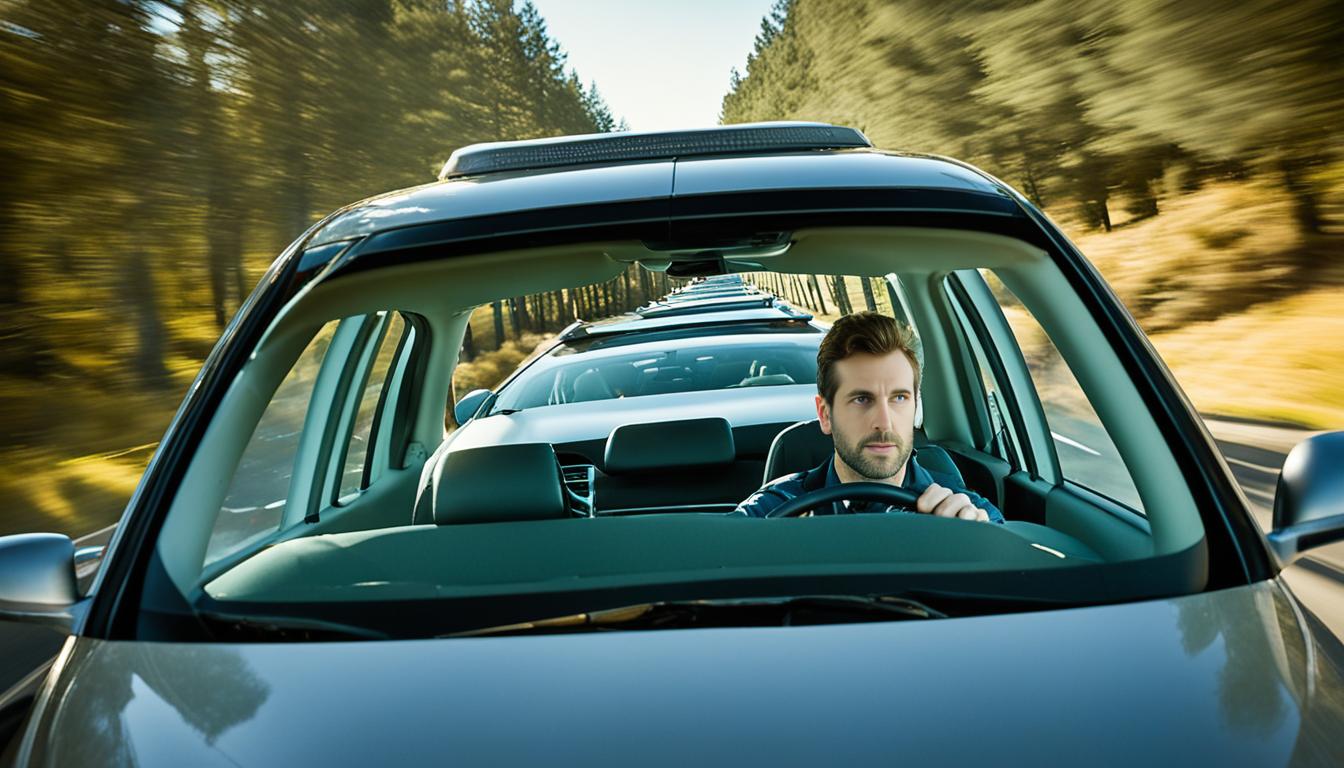A Driver Should Know These Safe Driving Tips
Safe driving is a crucial aspect of responsible driving. By practicing safe driving habits, you can reduce the risk of accidents, ensure your safety, and promote road safety for everyone. Whether you are a new driver or have years of experience behind the wheel, it is important to stay updated on safe driving practices.
Incorporating defensive driving skills, following traffic rules, and maintaining regular vehicle maintenance are key elements of safe driving. By adopting these practices, you can enhance your driving abilities and protect yourself and others on the road.
Key Takeaways:
- Safe driving habits are essential for responsible driving.
- Practice defensive driving skills to anticipate potential hazards and be prepared to avoid accidents.
- Always follow traffic rules and obey speed limits to create safer road conditions.
- Maintain regular vehicle maintenance to minimize the risk of mechanical failures.
- Remember to wear seat belts at all times to protect yourself in the event of an accident.
Ignoring Distractions and Maintaining Focus

In order to drive safely, it is important to prioritize your focus on the road and avoid distractions. Multitasking and using electronic devices, such as mobile phones, while driving can significantly impair your ability to react quickly, increasing the risk of accidents.
“Safe driving requires your undivided attention. Distractions can come in many forms, but the consequences are always the same – an increased likelihood of accidents.”
When behind the wheel, it is crucial to prioritize your safety and the safety of others. Avoiding distractions means refraining from texting or talking on the phone, checking emails, or engaging in any other activities that take your attention away from the road. Your full attention should be dedicated to the task of driving.
Focus on the Road
Keep your eyes on the road at all times and be aware of your surroundings. Avoid any activities that may divert your attention, such as eating, grooming, or adjusting electronic devices. If you need to use your phone or any other electronic device, pull over to a safe location.
“Remember, no text, call, or social media notification is more important than your safety and the safety of others on the road.”
Avoid Multitasking
It’s important to avoid multitasking while driving. Tasks such as eating, drinking, or changing the music can take your focus away from the road, impairing your ability to react quickly to potential hazards. Focus solely on driving to ensure your safety and the safety of those around you.
Lead by Example
As a responsible driver, you can set a good example for others. When driving with passengers, especially children, demonstrate the importance of avoiding distractions and maintaining focus. By prioritizing safe driving habits, you can help create a safer environment on the roads.
Remember, staying focused and avoiding distractions are key to safe driving. By eliminating multitasking and refraining from using electronic devices while behind the wheel, you can reduce the risk of accidents and ensure a safer journey for yourself and others on the road.
Mastering Defensive Driving Techniques

Defensive driving is a crucial skill for every driver. It not only helps protect you and your passengers but also contributes to overall road safety. By adopting defensive driving techniques, you can anticipate potential hazards, maintain a safe distance from other vehicles, and be prepared to avoid accidents.
One of the key aspects of defensive driving is anticipating potential hazards on the road. This means constantly scanning the environment and being vigilant for any signs of danger. By staying aware of your surroundings, you can identify and react to potential threats in a timely manner.
Maintaining a safe distance between your vehicle and the one in front of you is another important defensive driving technique. By keeping a sufficient gap, you have more time to react if the vehicle ahead suddenly stops or maneuvers. Remember, the three-second rule is a useful guideline to ensure a safe following distance.
Being aware of other drivers’ actions is also crucial in defensive driving. Pay attention to their behaviors, such as sudden lane changes, aggressive driving, or distracted driving. This awareness allows you to anticipate and adjust your own driving accordingly to avoid potential collisions.
Constantly scanning the road ahead, to the sides, and behind you helps you identify potential hazards before they become immediate risks. By actively looking for potential dangers, such as pedestrians, cyclists, debris on the road, or adverse weather conditions, you can proactively take evasive actions to avoid accidents.
Benefits of Defensive Driving Techniques
“Defensive driving techniques provide drivers with the necessary skills and mindset to navigate the roads safely. By being proactive and prepared, you can significantly reduce the likelihood of accidents and protect yourself and others.”
Here is a table showcasing the benefits of mastering defensive driving techniques:
| Benefits of Defensive Driving Techniques |
|---|
| Avoiding collisions and accidents |
| Reduced risk of injuries to yourself and passengers |
| Promoting overall road safety |
| Lowers insurance premiums through safe driving records |
| Improved fuel efficiency by maintaining a consistent speed |
| Managing stress levels while driving |
Mastering defensive driving techniques is an investment in your safety and the safety of others on the road. By implementing these skills, you can navigate various driving situations with confidence and reduce the risk of accidents.
Following Traffic Rules and Speed Limits

When it comes to safe driving, one of the most important aspects is following traffic rules and speed limits. These guidelines are put in place to ensure the safety of all drivers on the road. By obeying traffic rules, drivers can help maintain order and prevent accidents. Let’s take a closer look at some key rules that every driver should keep in mind:
Stop at Stop Signs
Stop signs are a common sight on our roads, and it is crucial to come to a complete stop when approaching them. This allows you to assess the traffic situation and proceed safely. Failing to stop at stop signs can lead to dangerous collisions, so always remember to bring your vehicle to a full stop.
Yield at Intersections
Intersections can be tricky, especially when multiple vehicles are trying to navigate through them. Yielding the right of way to other vehicles when necessary is an important rule to follow. Taking the time to yield and allow others to proceed can help prevent accidents and keep the traffic flow smooth.
Obey Speed Limits
Speeding is a common problem on our roads, but it’s also one of the leading causes of accidents. Each road has a designated speed limit that drivers must adhere to. Speed limits are set based on various factors, including road conditions and surrounding areas. By obeying the speed limits, drivers can reduce the risk of accidents and ensure a safer driving experience for everyone.
“Obeying traffic rules and speed limits is not just about avoiding tickets; it’s about protecting yourself and others on the road.” – James Anderson, Driving Safety Expert
By following traffic rules and speed limits, drivers can contribute to safer road conditions and help prevent accidents. These rules are designed to protect everyone on the road, so let’s do our part and make safe driving a priority.
| Traffic Rules to Follow | Benefits |
|---|---|
| Stop at stop signs | Prevent collisions and ensure intersection safety |
| Yield at intersections | Prevent accidents and maintain smooth traffic flow |
| Obey speed limits | Reduce the risk of accidents and create safer road conditions |
Regular Vehicle Maintenance

Proper vehicle maintenance is essential for safe driving. Regularly maintaining your car can help prevent mechanical failures and minimize the risk of accidents. Here are some important aspects of regular car upkeep that every driver should be aware of:
1. Checking Headlights and Turn Signals
Ensuring that your headlights and turn signals are in proper working condition is crucial for visibility on the road. Regularly check that all bulbs are functioning correctly and replace any burnt-out bulbs immediately. Remember to test your turn signals before every journey to communicate your intentions to other drivers effectively.
2. Checking Tire Pressure
Proper tire pressure is vital for maintaining optimal traction and stability while driving. Use a tire pressure gauge to check the pressure regularly, including the spare tire. Consult your vehicle’s manual or the sticker inside the driver’s side door frame to find the recommended PSI (pound-force per square inch) for your car’s tires.
3. Checking for Leaks
Inspecting your vehicle for leaks is an important part of regular maintenance. Check under your car for any signs of fluid leakage, such as oil or coolant. Leaks can indicate potential mechanical issues that should be addressed promptly to prevent further damage or accidents.
“Regular vehicle maintenance can help prevent mechanical failures and minimize the risk of accidents.”
4. Minimizing Distractions on the Road
While not directly related to vehicle maintenance, minimizing distractions while driving is crucial for safe journeys. Avoid using mobile phones or other electronic devices, as these can divert your attention from the road. Instead, focus on the task at hand and fully engage in driving to ensure your safety and the safety of others.
| Benefits of Regular Vehicle Maintenance | Actions to Take |
|---|---|
| Prevents mechanical failures | Regularly check and service your vehicle’s components |
| Minimizes the risk of accidents | Inspect headlights, turn signals, tire pressure, and fluids |
| Improves overall vehicle performance | Follow the maintenance schedule provided by the manufacturer |
| Prolongs the lifespan of your vehicle | Address any issues promptly to prevent further damage |
By following these regular vehicle maintenance practices, drivers can ensure that their vehicles are in optimal condition, promote safety on the road, and minimize the risk of accidents caused by mechanical failures. Remember, a well-maintained vehicle leads to a safer and more enjoyable driving experience!
Importance of Seat Belt Usage

Wearing seat belts is one of the most effective ways to protect yourself and your passengers in the event of an accident. It is crucial for drivers and passengers to always wear seat belts and ensure that children are properly buckled in their seats. Seat belts play a significant role in reducing the risk of fatalities and serious injuries in car accidents.
Seat belts provide vital protection by restraining occupants and preventing them from being thrown from the vehicle during a collision. They also distribute the forces of impact across the strongest areas of the body, minimizing the risk of severe injuries. By wearing seat belts, individuals can greatly increase their chances of survival and minimize the severity of potential injuries.
Children, in particular, should be securely buckled in appropriate child safety seats or booster seats that are suitable for their age and size. This ensures that they are properly protected and reduces the risk of injury in case of an accident.
“Seat belts can be the difference between life and death in a car accident. As a driver, it is not just your responsibility, but also your legal obligation to ensure that all occupants are wearing seat belts. It’s a simple action that can make a world of difference in ensuring everyone’s safety.”
Seat Belts Reduce Fatalities and Injuries
Research shows that seat belts are highly effective in reducing fatalities and injuries in car accidents. According to the National Highway Traffic Safety Administration (NHTSA), seat belts saved an estimated 14,955 lives in 2017 in the United States alone. It is estimated that if all vehicle occupants wore seat belts, an additional 2,549 lives could have been saved.
Seat belts not only save lives but also prevent serious injuries. In the event of a crash, properly restrained occupants are less likely to suffer severe head, chest, and spinal cord injuries compared to those who are not wearing seat belts. By buckling up, drivers and passengers can significantly reduce the risk of life-altering injuries.
| Year | Seat Belt Usage Rate | Lives Saved |
|---|---|---|
| 2015 | 89.6% | 14,143 |
| 2016 | 90.1% | 14,668 |
| 2017 | 90.7% | 14,955 |
Handling Accidents and Emergency Situations

Knowing how to handle accidents and emergency situations is crucial for every driver. In the unfortunate event of an accident, it is important to remain calm and follow a few essential steps to ensure the safety of everyone involved and expedite the resolution of the situation.
Check for Injuries
The first priority after an accident is to check for injuries. The well-being of all individuals involved should be the primary concern. If anyone is injured, contact emergency services immediately for medical assistance. If there are no visible injuries, it is still advisable to seek medical attention to rule out any potential internal injuries that may not be immediately apparent.
Exchange Information
After ensuring the safety of those involved, it is crucial to exchange contact and insurance information with the other party or parties involved in the accident. Obtain their full name, phone number, address, and insurance details. Provide them with your own contact and insurance information as well. This information is essential for filing an insurance claim and resolving any potential legal issues that may arise.
Contact Insurance Provider
Once the necessary information has been exchanged, promptly contact your own insurance provider to report the accident and initiate the claims process. Provide them with all the relevant details of the accident, including the date, time, location, and a description of what occurred. Be prepared to provide any supporting documents or evidence, such as photographs or eyewitness statements, to assist with the claims process.
Handling accidents and emergency situations can be stressful, but by following these guidelines, drivers can ensure that the necessary steps are taken to protect themselves and others involved. Acting quickly, responsibly, and cooperatively can help facilitate a smooth resolution to the situation.
| Steps to Handle Accidents and Emergency Situations |
|---|
| 1. Check for injuries |
| 2. Exchange contact and insurance information |
| 3. Contact insurance provider to report the accident |
Importance of Speed Limits and Traffic Laws

Adhering to speed limits and traffic laws is crucial for maintaining safe road conditions and preventing accidents. By following these regulations, drivers can protect themselves and others on the road.
One essential aspect of traffic laws is respecting speed limits. Speed limits are put in place to ensure the safety of all road users and to account for various factors such as road conditions and visibility. By driving within the posted speed limits, drivers can maintain better control of their vehicles, react more effectively to unexpected situations, and reduce the risk of collisions.
Another crucial traffic law is the requirement to yield to emergency vehicles. When drivers see or hear approaching emergency vehicles with their sirens and lights on, it is their obligation to yield the right-of-way and make way for these vehicles to pass safely. This allows emergency responders to reach their destinations quickly, potentially saving lives.
Passing a stopped bus displaying a stop sign is strictly prohibited by traffic laws. This safety measure ensures the safety of children crossing the road and prevents accidents. It is vital for drivers to be patient and wait for the bus to resume its journey before proceeding.
In addition to obeying speed limits and traffic laws, it is essential for drivers to remain alert and attentive to their surroundings at all times. This includes avoiding distractions, such as using mobile phones or engaging in other activities that take their focus away from the road. By staying focused and adhering to traffic laws, drivers can significantly reduce the likelihood of accidents and contribute to safer roadways for everyone.
- Always adhere to posted speed limits to maintain control and reduce the risk of accidents.
- Yield to emergency vehicles to allow them to reach their destinations quickly and safely.
- Avoid passing stopped buses displaying a stop sign to ensure the safety of children and prevent accidents.
- Stay alert and attentive, avoiding distractions that can impair driving performance.
Dangers of Impaired Driving
Driving under the influence of alcohol or drugs is extremely dangerous and can have severe consequences. It is important for drivers to never drink and drive and to always have a designated driver or alternative transportation arranged if they plan on consuming alcohol. Impaired driving can result in serious accidents, injuries, and legal consequences.
“Drunkenness is not evidence of any kind of bravery, it is simply a manifestation of foolishness.” – Alexei Navalny
Impaired driving not only puts the driver at risk but also endangers the lives of others on the road. Alcohol and drugs can significantly impair a driver’s judgment, coordination, and reaction time, making it difficult to operate a vehicle safely. It is critical to prioritize the safety of oneself and others by making responsible choices when it comes to drinking and driving.
The Consequences of Driving Under the Influence
Driving under the influence has severe consequences that extend beyond the risks of accidents and injuries. Legal repercussions for impaired driving can include heavy fines, license suspension, mandatory alcohol education programs, probation, and even imprisonment.
Additionally, the emotional toll of impaired driving accidents cannot be understated. Lives can be irrevocably changed, families torn apart, and lasting trauma inflicted. The implications of choosing to drive under the influence can have far-reaching consequences that extend beyond the immediate incident.
It is crucial to prioritize safety and make responsible decisions when it comes to consuming alcohol or drugs. Having a designated driver, utilizing ride-sharing services, or arranging alternative transportation can save lives and prevent the devastating effects of impaired driving.
| Impaired Driving Statistics | Consequences |
|---|---|
| In the United States, approximately 29 people die every day in alcohol-impaired vehicle crashes, equating to one death every 50 minutes. | Legal penalties, fines, license suspension, mandatory alcohol education, probation, imprisonment, and lasting emotional trauma. |
| Alcohol is involved in nearly one-third of fatal traffic accidents in the United States. | Potential for serious injuries, disabilities, and fatalities for drivers, passengers, and innocent bystanders. |
| Driving under the influence can result in a criminal record, which can impact employment opportunities, professional licenses, and personal reputation. | Stigmatization, difficulty finding employment, potential loss of career and educational opportunities. |
These statistics highlight the importance of making responsible decisions and avoiding impaired driving at all costs. The risks and consequences are too high to justify taking such a dangerous and irresponsible action.
Safe Driving in Winter Conditions
Driving in winter conditions can be challenging and hazardous. It is important for drivers to take extra precautions to ensure their safety and the safety of others on the road. By practicing safe driving habits in winter, drivers can reduce the risk of accidents and ensure a safer journey.
1. Increase Following Distance: In winter weather, it takes longer for vehicles to come to a stop. To allow for a proper stopping distance, increase your following distance from the car in front of you. This will give you enough time to react and prevent any potential collisions.
2. Get Enough Rest Before Driving: Fatigue can impair your reaction time and judgment while driving, especially in winter conditions. Make sure to get enough rest before embarking on a winter journey to stay alert and focused on the road.
3. Be Cautious in Bad Weather: Winter weather often brings snow, ice, and slippery road conditions. Adjust your driving accordingly and lower your speed to match the conditions. Always keep a lookout for black ice, which can be particularly treacherous.
| Safe Driving Tips for Winter | Explanation |
|---|---|
| 1. Increase Following Distance | Allow for a longer stopping distance to prevent collisions. |
| 2. Get Enough Rest Before Driving | Avoid fatigue and stay focused on the road. |
| 3. Be Cautious in Bad Weather | Adjust your driving and lower your speed to match the conditions. |
Remember, winter driving safety is crucial for all motorists. By following these tips and exercising caution, you can navigate winter conditions with confidence and arrive at your destination safely.
Avoiding Driver Fatigue and Drowsiness
Driver fatigue and drowsiness can significantly impair a driver’s ability to operate a vehicle safely. It is crucial for drivers to prioritize their well-being and take necessary measures to combat fatigue while on the road. Here are a few tips to help you stay alert and avoid drowsy driving:
- Get enough rest: Prioritize getting an adequate amount of sleep before embarking on long drives. Aim for at least 7-8 hours of sleep to ensure you are well-rested and alert.
- Take breaks during long drives: Plan your journey in advance and schedule regular breaks. Every 2 hours or 100 miles, take a short break to stretch your legs, grab a snack, or simply relax. This will help combat fatigue and keep you focused on the road.
- Avoid driving when feeling drowsy: If you feel tired or drowsy while driving, it is essential to pull over at a safe location and rest. Trying to push through exhaustion can put you and others at risk. Take a power nap or find a nearby rest area to rejuvenate before continuing your journey.
By staying alert and avoiding driver fatigue, you can significantly reduce the risk of accidents caused by tiredness. Remember, your safety and the safety of others on the road should always be a top priority.
Remember:
“A rested driver is a safe driver.” – National Highway Traffic Safety Administration
Conclusion
Safe driving should always be a priority for every driver. By following these safe driving tips, drivers can promote road safety, minimize the risk of accidents, and ensure a safer journey for themselves and others on the road. Responsible driving and adherence to traffic laws and safety practices are crucial for a safer and more enjoyable driving experience.
By consistently practicing safe driving habits, such as avoiding distractions, maintaining focus, and practicing defensive driving techniques, drivers can greatly reduce the chances of being involved in an accident. It is important to remember to always follow traffic rules, including obeying speed limits, stopping at stop signs, and yielding at intersections.
Regular vehicle maintenance is also essential for safe driving. By regularly checking headlights, turn signals, tire pressure, and inspecting for any leaks or mechanical issues, drivers can ensure their vehicle is in optimal condition and minimize the risk of mechanical failures on the road. Additionally, wearing seat belts is one of the simplest yet most effective ways to protect oneself in the event of an accident.
By promoting responsible and safe driving practices, we can all contribute to a safer road environment. Remember, road safety is not just a personal responsibility, but a collective one. Let’s work together to create a culture of safe driving and make our roads safer for everyone.
FAQ
Why is safe driving important?
Safe driving is important because it helps prevent accidents and promotes road safety. By following safe driving habits and practicing defensive driving skills, drivers can minimize the risk of accidents and ensure a safer journey for themselves and others on the road.
How can I avoid distractions while driving?
To avoid distractions while driving, it is important to ignore multitasking and not use mobile phones or any other electronic devices. Distractions can impair your ability to react quickly and increase the risk of accidents. Maintain focus on the road and avoid any activities that take your attention away from driving.
What is defensive driving?
Defensive driving is a crucial skill for every driver. It involves anticipating potential hazards, expecting the unexpected, and being prepared to avoid accidents. Some key defensive driving techniques include maintaining a safe distance between your car and the one in front of you, being aware of other drivers’ actions, and constantly scanning the road for potential hazards.
Why is it important to follow traffic rules and speed limits?
Following traffic rules and speed limits is essential for safe driving. This includes stopping at stop signs, yielding at intersections, and obeying the posted speed limits. By following these rules, drivers can reduce the risk of accidents and promote safer road conditions.
How often should I maintain my vehicle?
Regular vehicle maintenance is crucial for safe driving. It is recommended to check headlights and turn signals to ensure they are working properly, check tire pressure to maintain optimal traction, and inspect the vehicle for any leaks or loose objects. By maintaining the vehicle, drivers can minimize the risk of mechanical failures that could lead to accidents.
Why should I wear seat belts?
Wearing seat belts is one of the most effective ways to protect yourself in the event of an accident. It is important for drivers and passengers to always wear seat belts and ensure that children are properly buckled in their seats. Seat belts can greatly reduce the risk of fatalities and serious injuries in car accidents.
What should I do in case of an accident?
If involved in an accident, drivers should first check for injuries and ensure the safety of themselves and others involved. They should then exchange contact and insurance information with the other party and contact their insurance provider to report the claim. It is important to follow the proper procedures to ensure a smooth resolution to the situation.
How important are speed limits and traffic laws?
Adhering to speed limits and traffic laws is essential for safe driving. Drivers should never pass a stopped bus displaying a stop sign and should always yield to emergency vehicles. By obeying speed limits and traffic laws, drivers can reduce the risk of accidents and create safer road conditions for everyone.
Why is impaired driving dangerous?
Driving under the influence of alcohol or drugs is extremely dangerous and can have severe consequences. It is important for drivers to never drink and drive and to always have a designated driver or alternative transportation arranged if they plan on consuming alcohol. Impaired driving can result in serious accidents, injuries, and legal consequences.
How can I drive safely in winter conditions?
Driving in winter conditions can be challenging and hazardous. It is important for drivers to take extra precautions, such as increasing their following distance, getting enough rest before driving, and being cautious in bad weather. By practicing safe driving habits in winter, drivers can reduce the risk of accidents and ensure a safer journey.
How can I avoid driver fatigue and drowsiness?
Driver fatigue and drowsiness can significantly impair a driver’s ability to operate a vehicle safely. It is important for drivers to get enough rest before embarking on long drives, take regular breaks, and avoid driving when feeling drowsy. By staying alert and avoiding driver fatigue, drivers can reduce the risk of accidents caused by tiredness.
What are some safe driving tips?
Safe driving should always be a priority for every driver. By following safe driving tips such as avoiding distractions, practicing defensive driving, following traffic rules and speed limits, maintaining proper vehicle maintenance, wearing seat belts, handling accidents and emergency situations properly, and adhering to safe driving practices in winter conditions, drivers can promote road safety and minimize the risk of accidents.







